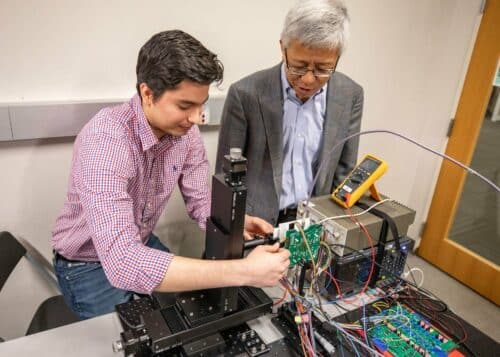Researchers from The University of Texas & Seoul National University have developed an imager chip that allows mobile devices to detect objects inside packages or behind walls.

Chip-enabled cell phones could detect studs, wooden beams, wiring behind walls, pipe cracks, or contents in envelopes and packages. This technology also has medical applications.
Researchers from The University of Texas at Dallas and Seoul National University have developed an imager chip inspired by Superman’s X-ray vision. This chip enables mobile devices to detect objects inside packages or behind walls.
With privacy in mind, the researchers designed the technology to operate only at close range, about 1 inch from an object. According to researchers, a thief trying to scan the contents of someone’s bag would need to be so close that the person would notice. The next version of the imager chip aims to capture images up to 5 inches away and better detect smaller objects.
“This technology is like Superman’s X-ray vision. Of course, we use signals at 200 gigahertz to 400 gigahertz instead of X-rays, which can be harmful,” said Dr. Kenneth K. O, director of the Texas Analog Center of Excellence (TxACE) and the Texas Instruments Distinguished University Chair in the Erik Jonsson School of Engineering and Computer Science.
The imager emits 300-GHz signals in the millimeter-wave band, between microwave and infrared frequencies, which are invisible to the human eye and considered safe. Similar technology, using microwaves, is employed in large, stationary passenger screeners at airports.
“It took 15 years of research that improved pixel performance by 100 million times, combined with digital signal processing techniques, to make this imaging demonstration possible. This disruptive technology shows the potential capability of true THz imaging,” said Dr. Brian Ginsburg, director of RF/mmW and high-speed research at TI’s Kilby Labs.
“We designed the chip without lenses or optics to fit into a mobile device. The pixels, which create images by detecting signals reflected from a target object, have the shape of a 0.5-mm square, about the size of a grain of sand,” said Dr Wooyeol Choi, assistant professor at Seoul National University and the author of the latest paper.
Reference: Pranith Reddy Byreddy et al, Array of 296-GHz CMOS Concurrent Transceiver Pixels With Phase and Amplitude Extraction Circuits for Improving Reflection-Mode Imaging Resolution, IEEE Transactions on Terahertz Science and Technology (2024). DOI: 10.1109/TTHZ.2024.3350515






